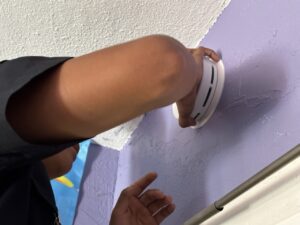Weather forecasters are predicting a major rain event this week. You may know that forecasters are calling this storm one of the strongest in years, with up to six inches of rain in just a few days. If you live in the hills, or anywhere in the City of Los Angeles where water may accumulate, you know you need sand bags to protect your property. But where do you get them? And how do you properly use sand bags to divert water and debris flows away from your home?
You can get as many as 25 free sand bags at nearly every Los Angeles City Fire Station. Just stop by your neighborhood fire station, ring the bell and ask for sand bags. Easy, right? But, sand bags aren’t much good without sand, and not all LAFD stations have sand to go with the sand bags. However, some 35 selected locations throughout the city DO have piles of the 250 tons of sand ordered from the Bureau of Street Services.
The LAFD has a complete list of stations that provide sand.
Now that you have your sand bags and know where to get the sand, grab a friend, a shovel, some plastic sheeting or an old blanket, a pair of gloves, sturdy shoes, and eye protection, and hit the sand pile. It’s up to you to fill up your own sand bags, and bring them back to your home … unless you want to hire someone to do it for you.
For the rest of us do-it-yourselfers, here’s the proper way to fill a sand bag. Have one person on shovel duty. The other should open the sand bag, and fold it over itself, protecting the fingers. Take a knee, and spread the bag open. The shoveler will put about a half of a shovelful of sand into the opening of the sand bag to weigh it down and keep it open.
Then, proceed to fill the sand bag about 1/3 full. This is important. You want to leave enough room to fold the sand bag closed when building your diversion berm; and a 1/3 full sand bag wont be as heavy to carry into place. As always, bend your knees and keep your back straight when lifting sand bags.
To transport the sand bags home, simply lay out the plastic sheeting (which you’ll also need for your diversion berm) or the blanket in the cargo area, trunk, or even back seat of your vehicle, and place the filled sand bags on top of it. That’ll keep the vehicle tidy. Make sure to distribute the sand bags weight evenly so as not to overload your vehicle. Depending on the size or ruggedness of your vehicle, you may need to make a couple trips. Or, you could have your fellow sand-bagger bring a vehicle to split-up the load. The filled sand bags will get heavy.
Here’s a short, educational video on the proper way to get and fill sand bags.
Sand bags are effective, but they’re not meant to create an impermeable water-barrier. They are meant to divert water away from your property. Water goes where it will. We can only hope to steer it, so keep that in mind when placing sand bags. Remember, NOW is the time to make sure you have the sand bags you need to protect your home. Don’t wait until it’s pouring rain, and the water is rising.
We missed El Niño last year, but we’re getting caught up this year. Don’t be left out of the important preparation process. Your home will be safer, and your family protected from unwanted water invasion.









